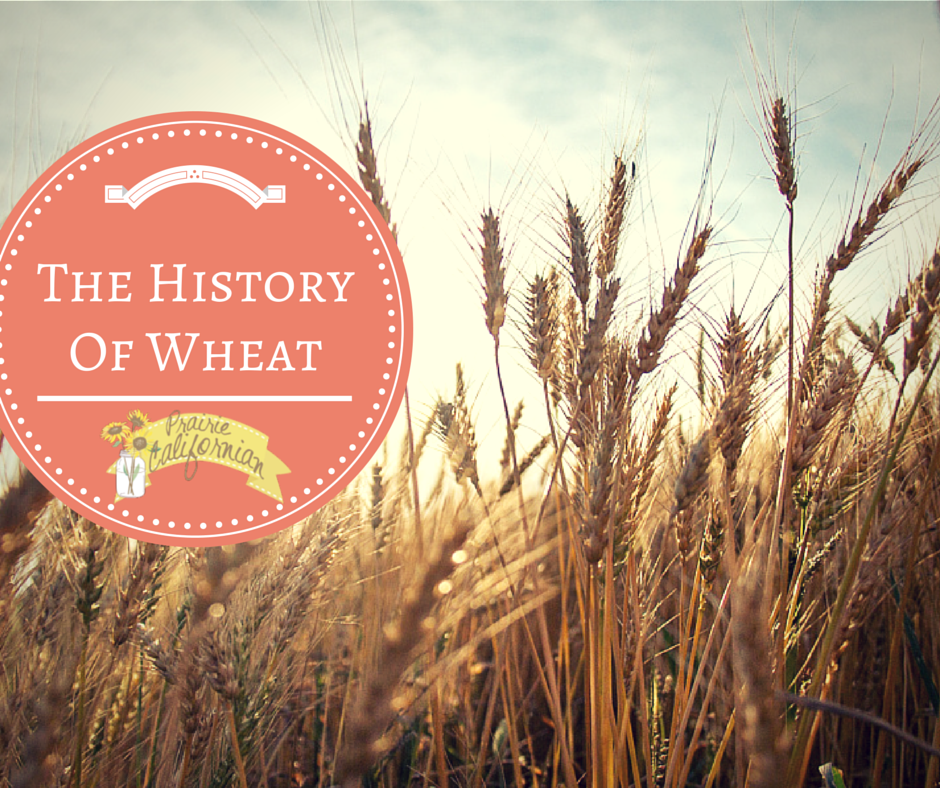
Welcome to week three all about wheat! Thanks to mainstream media, wheat has kind of gotten a beat down. Wheat has been blamed for the evils of the healthy world like celiac’s disease, obesity, and more. And through these blame games, there are a lot of myths I see put out there about wheat. In the first part of this journey, I addressed the Truth Behind Toxic Wheat and then last week we talked about how not all wheat is created equal and the Six Classes of Wheat.
Many people blame modern-day wheat as if somehow wheat has changed its genetic structure and has drastically changed from what we would now call “heritage wheats” of the past. It may be true that some aspects of this “modern wheat” is much different from when it was originally domesticated. It can be shorter, have higher yields and larger heads.
But there is no crop plant in the developed world – from grasses to flowers to food products – that is the same as when it first existed when the Earth was formed. And neither are the environments in which it was first grown. I’ve said before that Agriculture is an ever-changing industry. There are no guarantees and nothing is ever the same.
This week I want to talk about the History of Wheat. But in order to understand the history of wheat, we are going to get into some genetics. I will break it down the best I can, so stick with me.
Diploid Wheat: Einkorn
Wheat was first domesticated nearly 10,000 years ago. One of the wheat forms originally domesticated is known as a diploid wheat called einkorn. Einkorn only has one genome usually designated with an A. A genome is an organism’s complete set of DNA, including all of its genes. Because einkorn contains two copies (two sets of chromosomes) of one genome, the plant designation is AA. These first domesticated diploid species of wheat are likely to have evolved from a common line that included wild oats, barley, and rye. One of the downsides of these wild grains is that they usually have small grains compared to larger grains of modern wheats.
In the centuries following domestication, the genome changed as a consequence of breeding and selection. Early farmers and breeders probably first selected seed favoring a larger size grain since larger grains are easier to recover during threshing.
Tetraploid Wheat: Emmer and Durum
Through selection for specific characteristics, polyploid wheats were born or wheats with more than one genome. Tetraploid wheats have two genomes (four sets of chromosomes) and are designated as AABB. Two common tetraploid wheats are emmer and durum. Emmer wheat is not what we call free-threshing. The grains are tightly encased in a husk (or glume) that is difficult to remove. Durum wheat is a free-threshing wheat as the seeds are easily released from the husk (or glume).
The main wheat during the time of the Roman empire was emmer and has recently made a comeback in gourmet cooking as farro. Durum wheats are still produced today, mainly in North Dakota and parts of Montana, for pasta. If you remember from last time, durum wheat, from the Latin word for hard, is the hardest of all wheat classes with amber-colored kernels larger than those of other wheat classes. Durum has a high protein content about 12.0 to 15.0 percent. When the durum is milled, the endosperm is ground into a granular product called semolina. Durum is also still extremely common in Italy and some Mediterranean countries.
Hexaploid Wheat: Spelt & Modern Varieties
The next step up in genetic complexity is hexaploid wheat. The A and B genomes of hexaploid wheat are nearly identical to the A and B genomes of tetraploid wheat, however, the hexaploid wheats have no wild equivalents. These hexaploid wheats resulted from hybridization of domesticated emmer and wild grass species. These hexaploid wheats are designated as AABBDD. (Don’t ask me what happened to C) and contain six sets of chromosomes.
With the exception of a hexaploid called spelt, the ABD wheats are free threshing and arose within the first thousand years of domestication. Isn’t it wild to think that nearly 8,000 years ago we were already experimenting with science and breeding these complex wheats? It wasn’t until the 1920’s that the art and science of wheat breeding begun in the United States.
There are two ways in which breeders create new wheat varieties.
Conventional crossing involves parents with complementary traits hybridized through natural fertilization to produce offspring with new genetic combinations, not introducing new genes as we see in GMOs. These new combinations are chosen based on their characteristics such as they may lead to slightly higher yield potential or have better resistance to diseases or pests. As of right now, there are no genetically modified wheats commercially available, there are however some research trials being done on genetically modified wheat.
The second method is to introduce genes indigenous to ancestral or related species of modern-day wheat and gradually incorporate these genes into a new wheat variety with minimal contribution of DNA from the ancestral species. This is achieved through selecting parents from wheat’s ancient lineage and crossing, not genetic engineering. Both methods utilize variation already found in wheat’s lineage. Modern wheat breeding has not created something completely new, it’s just a matter of rearranging or recombining different gene combinations together to create a new variety.
As Dr. Brett Carver of OSU says, “If we think of the ancient relatives of modern-day wheat as a genetic reservoirs, then at some point we will have exhausted those reservoirs as a means to combat ever-emerging diseases and insects or to address other challenges our farmers may face. With that perspective, university and private-company scientists are committed to adopting the technologies we so desperately need to unleash and capture new genetic reservoirs critical to wheat’s stable production and healthy consumption. This is our future.”
Protein Content: A Rise in Gluten?
Throughout those 10,000 years of wheat domestication, it was not possible to measure the protein content of the grain. Only about 250 years ago did the concept of measuring protein develop. Now a days, the rise in gluten intolerance is often blamed on the rise of protein in wheat. As we learned last time, gluten content and protein are directly related. So let’s look at this so called, rise in gluten.
Hexaploid wheats are what most of our common modern wheats are today. We learned last time about hard and soft wheat classes, what this is referring to is the endosperm texture. In hard wheats, a higher protein content is desired (12 – 14%) and are used for bread making. In soft wheats, a lower protein content is desired (7 – 11%) and are used more for pastries. All purpose flour has a protein content somewhere in the middle, often utilizing mixing different classes of wheat to achieve this. This blending or mixing of flour for all purpose use makes it desirable for many different uses.
Let’s use hard red spring wheat as a case study, which we grow here in North Dakota as well as on our own farm. HRS typically tends to exceed protein contents of winter wheat by about 2 percent. However, if we look at the protein data throughout the years, hard red spring wheat only varies about 3-4 percent from year to year, typically falling in the 12-16% range for protein. These same percentages of average protein can be seen in hard red spring wheat for nearly 100 years.
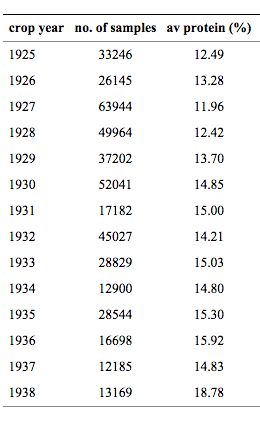
You will notice that in 1938, the average protein being extremely high in the 18 percent range. What the chart doesn’t tell you is that farmers probably only raised 10 bushel/acre wheat as we are all aware of the widespread drought that occurred in the Plains during the 1930s.
Wheat’s critics often tout we’ve created some sort of frankenwheat that produces not only high protein, but also high yields. More often than not, wheat is not breed for selecting protein, it is bred for selecting other traits like yield or resistance. There can be an inverse relationship or factor that as bushels increase, protein percentage decreases. Here on the farm, when we raise lower bushel/acre wheat it will typically be higher in protein whereas like this last year, our bushels were higher but our protein percentage was down. To produce high protein there must be enough nutrient resources to meet wheat’s requirements for growth and grain yield. If available nitrogen and nitrogen uptake satisfy growth and yield requirements, extra nitrogen is used for increasing grain protein. Grain from wheat stressed by drought or high temperatures during grain fill frequently has higher protein as well.
If we pick up average protein percentages up in 2006 where I can find data, we find much of the same and in fact a slight decrease in protein.
Donald Kasarda summarizes these findings well in the Journal of Agricultural and Food Chemistry by stating, “The connection between celiac disease and wheat ingestion was not made until 1950, so that any variations in the incidence of celiac disease prior to that would not have been distinguished from gastrointestinal diseases in general. Even today, data for the incidence of celiac disease that could have used to recognize short-term variations are not available. With acknowledgement that the data are available were not suited for rigorous statistical interpretation, I found no evidence of any obvious trend toward higher protein content for either spring or winter wheats since the early part of the 20th century when the key ancestral varieties of current bread wheats were introduced to the United States.”
Despite pretty conclusive evidence that protein percentages have remained the same for quite some time, people like Dr. William Davis, writer of the wildly popular book Wheat Belly, spread misinformation such as “wheat proteins undergo structural change with hybridization In one hybridization experiment, fourteen new gluten proteins were identified in the offspring that were not present in either parent wheat plant.”
This couldn’t be further from the truth. Plants can only express proteins they have the DNA code to produce. Creating a new or unique protein actually requires a mutation of the DNA. The kind of protein (gluten) that is present in our modern wheat varieties is the same protein that has been present in the older varieties that our grandparents and ancestors grew. It is not some sort of new protein. However, many variations can naturally exist in wheat protein. Environmental conditions can cause or inhibit the expression of certain proteins, but they cannot code for proteins that aren’t in the genome.
The Bottom Line…
When it comes to wheat, gluten, and autoimmune diseases like celiac’s disease, it is important to remember correlation does not equal causation. It is indeed true that during the time when celiac’s disease came up in our radar, wheat consumption was on the rise. However since the early 2000’s wheat consumption has actually been on the decrease, whereas obesity rates continue to increase.
NPR interviewed celiac expert Daniel Leffler, “I don’t think there’s one evil food causing the problem in our society. There’s good evidence that the vast majority of people actually do just fine with wheat. We sort of chafe at these oversimplistic theories that purport to explain an entire rise in a disease.” Don’t think you need to avoid wheat if you enjoy bread and pasta and tolerate them well. And if you think you may have an insensitivity, consult a doctor. Don’t home diagnose as there may be another more serious problem.
Wheat has been an important staple of the human diet for thousands of years, since it was first domesticated nearly 10,000 years ago. Wheat grain is an important source of starch and protein for many developing countries. Currently, wheat provides 21 percent of all food calories in the world. And for 4.5 billion people in 94 developing countries, wheat provides 20 percent of their protein intake. While it may be easy to criticize wheat here where our grocery store shelves, pantries, and tables are full of food, the truth is that many people across this globe depend on wheat to survive. Just as we have for the last 10,000 years.
Resources
Barclay, E. Aubrey, A. (2013). Doctors Say Changes in Wheat Do Not Explain Rise of Celiac's Disease.
Carver, B. (2013). Expert Answer on Wheat.
Carver, B. (2014). Rooting Out Fiction to See the Facts of Today's Wheat.
Jones, J. (2012). Wheat Belly - An Analysis of Selected Statements and Basic Theses from the Book. CFW, 57, 4, 177-189
Kasarda, D. (2013). Can an Increase in Celiac Disease Be Attributed to an Increase in the Gluten Content of Wheat as a Consequence of Wheat Breeding? JAFC, 61, 1155-1159
National Wheat Improvement Committee. (2013). Wheat Improvement: The Truth Unveiled.
North Dakota Wheat Commission (2014). Hard Red Spring Wheat Quality Reports. Schultz, S. (2014). The Skinny on Modern Wheat.

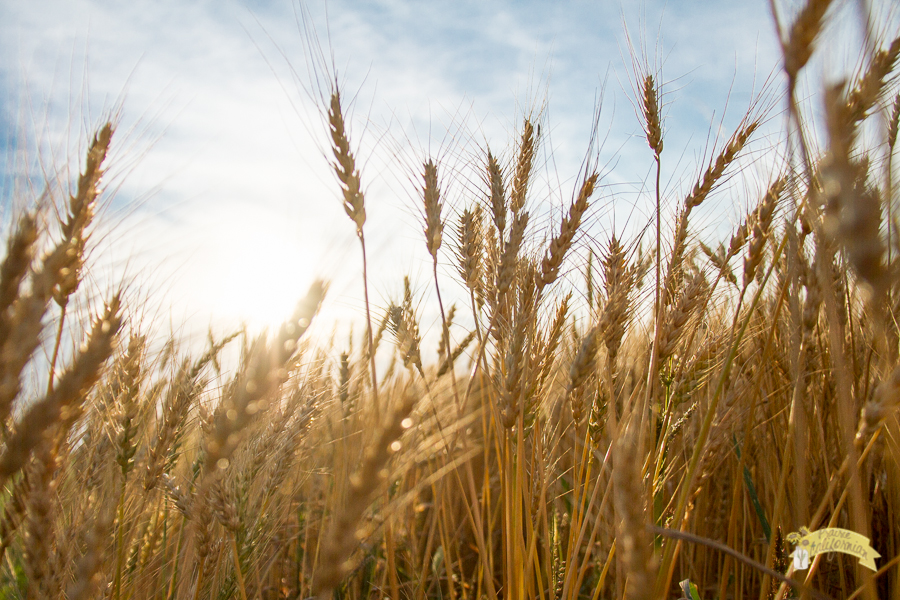
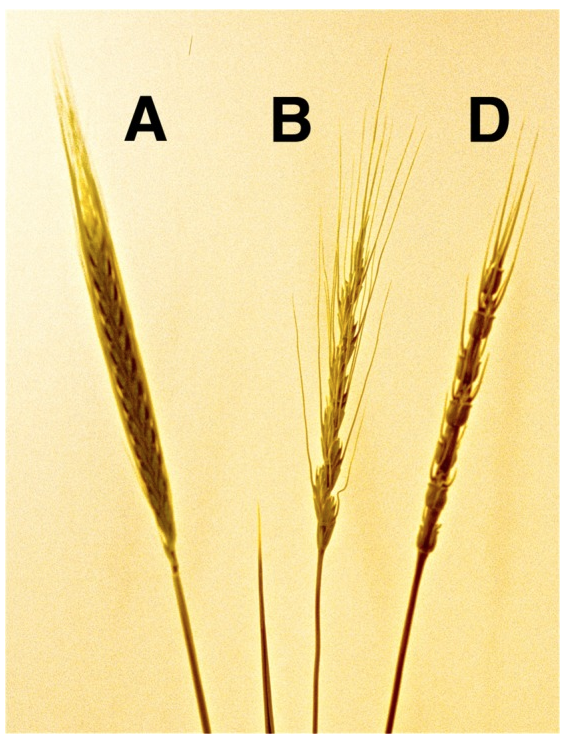

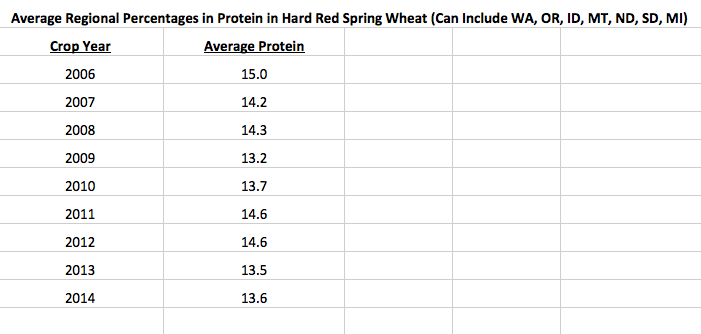
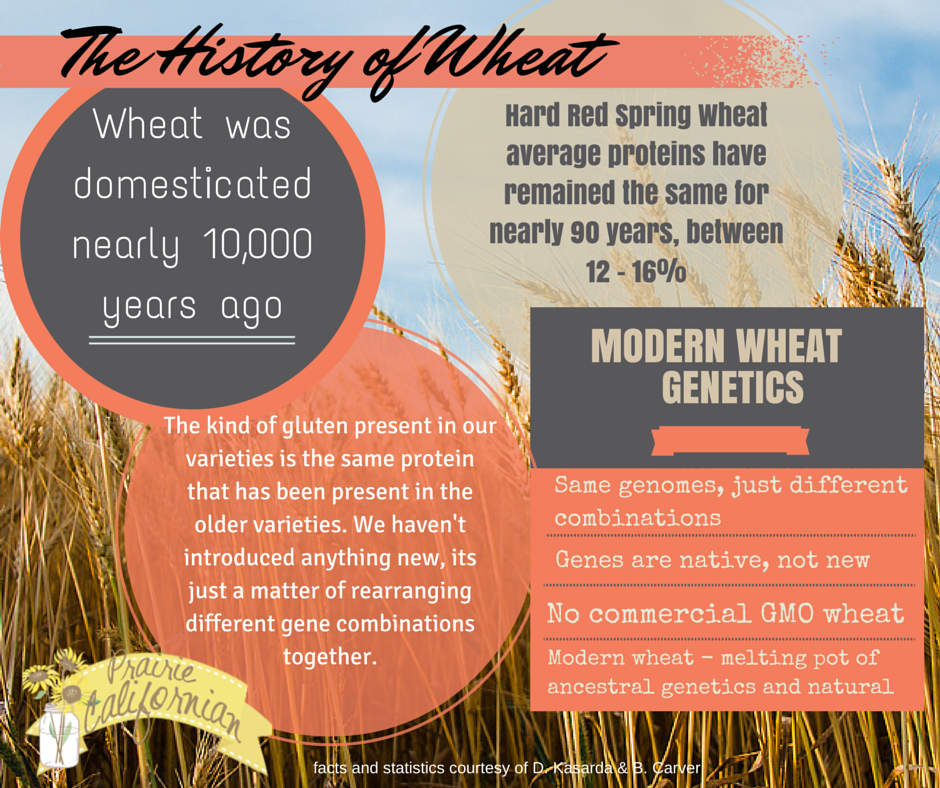
Great job Jenny. Nicely written and very understandable. Hope this will speak to some who are seeking the truth.